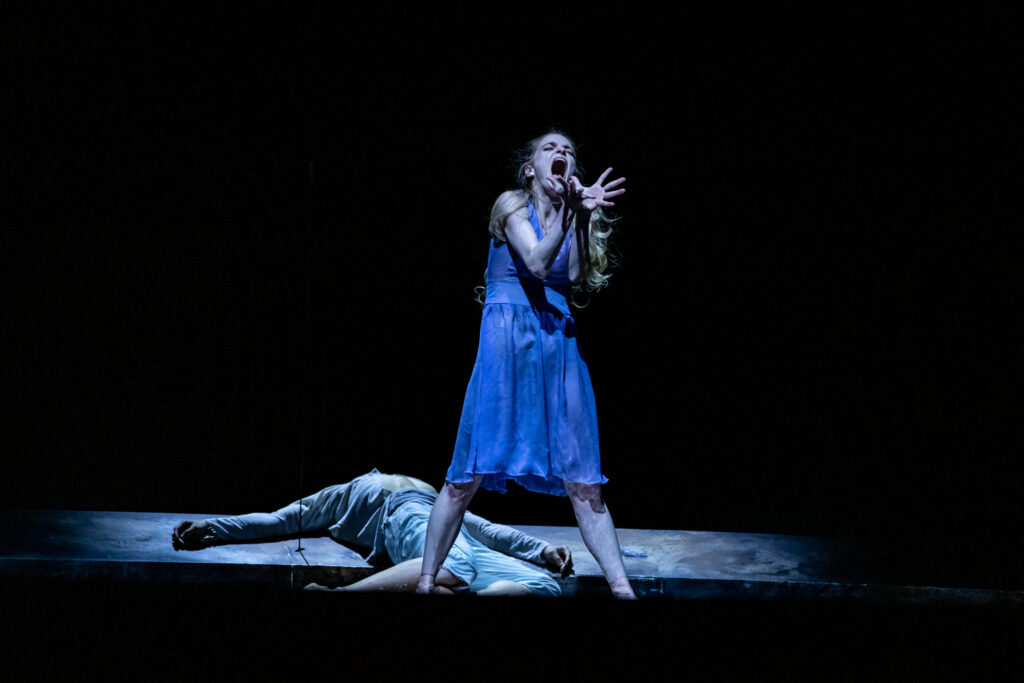
In a world focused relentlessly on the future, it can be both a relief and an exhilaration to encounter new art that’s truly timeless. That’s what happened at the War Memorial Opera House on Saturday, Jan. 21, during the second program ofSan Francisco Ballet’snext@90 festivalas an enraptured audience took in the premiere of Bridget Breiner’s “The Queen’s Daughter.”
This is a superbly nuanced, deeply moving piece of pure movement storytelling that might even drive some to tears, and deserves a permanent place in the repertoire.
The titular daughter is Salome, who dances for the king with her seven veils and then asks for John the Baptist’s head. It’s a biblical story arts-goers know in myriad versions, from Oscar Wilde’s play and Richard Strauss’歌剧阿瑟·皮塔饼的可怕balle服t, which was presented on the San Francisco’s Opera House stage in 2017. But Breiner has, thank goodness, washed all those renditions from her imagination. Hers is the first Salome I’ve seen with the power to shred your heart.
Review: S.F. Ballet next@90 launches with visually and sonically fresh new works
Review: Bold and ambitious, S.F. Ballet’s next@90 continues to awe

Breiner’s central empathetic insight is that Salome, a character not so much danced as startlingly embodied by Sasha De Sola, is caught between an ineffectual mother and a lustful narcissist father. There are many edge-of-your-seat moments in this 30-minute ballet, but perhaps the most devastating is when the queen, played by Jennifer Stahl, sees her husband on the verge of molesting her child and does not have the strength to intervene.
This is a domestic tragedy about stolen innocence that feels as real and eternally relevant as Greek theater, a form Breiner draws on in her use of a nine-member chorus that circles the action. Another key insight is that Salome’s strip-tease is no seduction at all, but rather a compulsory performance akin to rape. To watch De Sola angrily tear the garments from her body is to understand the convoluted strategies a mind devises to survive entrapment.
Even after this devastation, there’s another layer of loss: the death of John the Baptist, felt all the more keenly because Wei Wang, perfect for the role, dances with the full body connectedness of a being living on a different spiritual plane.
Nine choreographers, nine new works for S.F. Ballet’s 90th anniversary

How has Breiner managed to convey all of this so well through pure movement? Well, though raised in Ohio, she spent most of her dancing career at Germany’s Stuttgart Ballet, where one suspects she learned a thing or two from performing the work of John Cranko, who created some of the world’s best story ballets before his death in 1973. Some might wonder if Britain’s dominant 20th century choreographer Kenneth MacMillan has also been an influence, or the more unusual work of Antony Tudor, though Breiner herself has cited Glen Tetley, also an Ohio native and a modern dance choreographer nearly forgotten here in his native America, as a key model.
Regular San Francisco Ballet viewers might draw comparisons to Breiner’s contemporary Cathy Marston, who has also made literary narrative ballets for the company. The difference between Marston and Breiner, though, is in their choice of music. Whereas Marston has patched together pieces or commissioned mediocre scores, Breiner chose a stunning if relatively little-known work from the classical canon, Benjamin Britten’s Violin Concerto from 1939. It is rarely played, in part because the violin solo is intense and formidable. How fortunate the San Francisco Ballet orchestra is to have a concertmaster, Cordula Merks, who could rise to the requirements, and a music director, Martin West, committed to the challenge.
S.F. Ballet’s new director seeks a balance — innovation with stability

There was not one weak link in “The Queen’s Daughter’s” premiere. Jürgen Franz Kirner’s costume design kept flourishes minimal yet communicated the cues needed to discern each character’s role. Jim French’s lighting imbued the center of the stage with a subtle spectral sparkle.
Enormous credit is also due to Tiit Helimets, the company’s MVP principal, who will give his last career performance inDanielle Rowe’s “Madcap” on Feb. 11 at the end of the festival’s run. His King was a monster, terrifyingly cool and controlled.

The evening began less compellingly with the premiere of Val Caniparoli’s “Emergence,” to music by Bulgarian composer Dobrinka Tabakova. This meditation on pandemic isolation showcases its eight-member cast handsomely, and contains a gorgeously tender duet for Lucas Erni and Angelo Greco at its core, but is otherwise too static.
The heat was on at the end of the evening, though, with a loud ovation for Yuka Oishi’s “Bolero.” Previewed almost in its entirety at theBallet’s gala performanceon Thursday, Jan. 19, it was even better Saturday with its deconstructed opening composed by Shinya Kiyokawa. The orchestra’s warm-up morphed into a fractured klezmer take on Ravel’s famous score as the large cast, in gray pantsuits, quirkily assembled.

Yuan Yuan Tan连帽,卑躬屈膝的,煽动英航吗llet proper, like a single cell that splits into a disturbing infinity. The orchestra had a bit of trouble this time under guest conductor Matthew Rowe, but the dancers — especially Joseph Walsh — still twitched and strutted majestically.
San Francisco Ballet’s next@90:Program B featuring works by Val Caniparoli, Bridget Breiner and Yuka Oishi. 2 p.m. Saturday-Sunday, Jan. 28-29; 7:30 p.m. Tuesday, Jan. 24, Thursday, Jan. 26, and Feb. 8; 8 p.m. Feb. 3. $29-$448. War Memorial Opera House, 301 Van Ness Ave., S.F. 415-865-2000.www.sfballet.org
